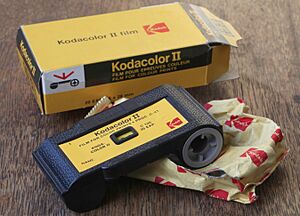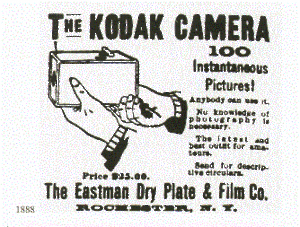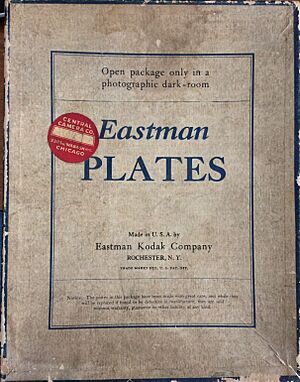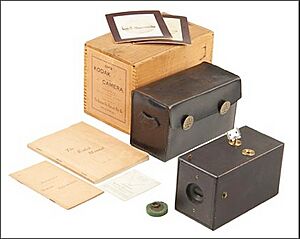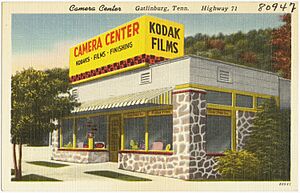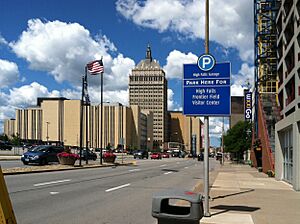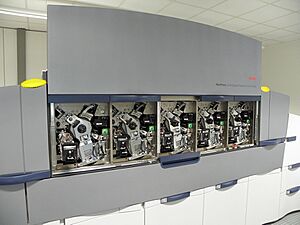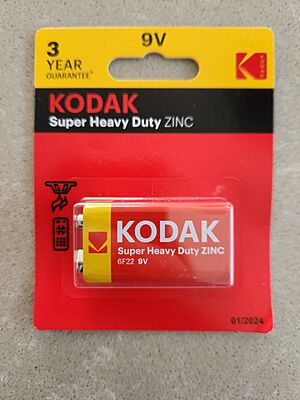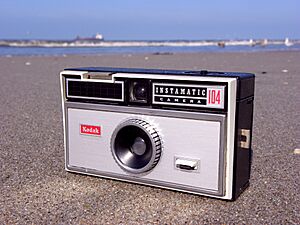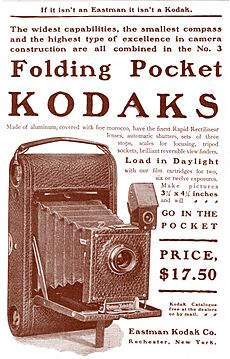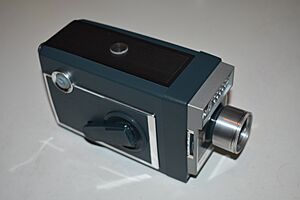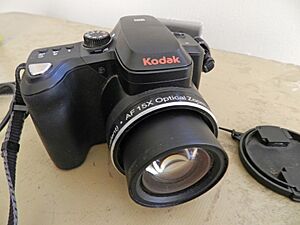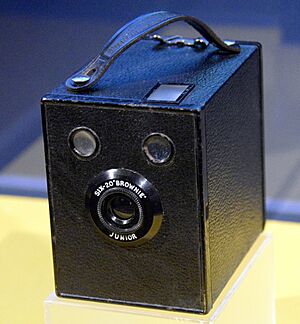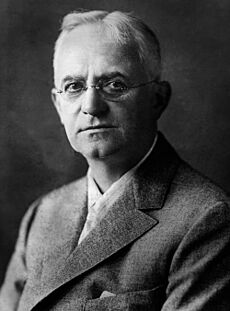Kodak facts for kids
The Eastman Kodak Company, usually called Kodak, is an American company known for its history in film photography. It's based in Rochester, New York, and was the first company to make photographic film available to everyone.
Kodak started when George Eastman and Henry A. Strong teamed up to create a camera that used film rolls. On May 23, 1892, Eastman Kodak officially became a company. Under George Eastman's leadership, Kodak grew into one of the world's biggest makers of cameras and film. They also created many new technologies through their research labs. Kodak made some of the most popular cameras of the 20th century, like the Brownie and Instamatic. Their famous slogan, "You Press the Button, We Do the Rest", meant that photography became easy for anyone.
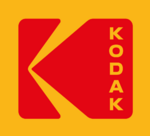 |
|

Headquarters in Rochester, New York
|
|
| Public | |
| Traded as |
|
| Industry |
|
| Predecessor | The Eastman Dry Plate and Film Company |
| Founded | May 23, 1892 |
| Founders |
|
| Headquarters | Kodak Tower Rochester, New York, U.S. |
|
Area served
|
Worldwide |
|
Key people
|
James V. Continenza (Executive chairman and CEO) |
| Products | Digital imaging, photographic materials, equipment and services, batteries |
| Revenue | |
|
Operating income
|
|
| Total assets | |
| Total equity | |
|
Number of employees
|
4,000 (2023) |
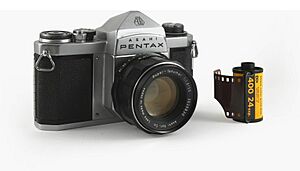
In the late 1990s, Kodak started having financial problems because of more competition from Fujifilm. The company also found it hard to switch from film to digital photography, even though Kodak had actually invented the first self-contained digital camera.
After trying to expand into other areas without success, Kodak focused on digital photography and digital printing in the 2000s. However, these plans didn't fix the company's money troubles. In January 2012, Kodak had to file for bankruptcy protection.
In September 2013, Kodak came out of bankruptcy. They had gotten rid of old debts and changed their business. Since then, Kodak has continued to offer commercial digital printing products, motion picture film, and still film. They also let other companies use the Kodak brand for products like digital cameras. In 2020, during the COVID-19 pandemic, Kodak even announced they would start making materials for medicines.
Contents
- History of Kodak
- What Kodak Makes Today
- What Kodak Used to Make
- Photographic Film and Paper
- Still Film Cameras
- Slide Projectors
- Instant Cameras
- Image Sensors
- Floppy Disks
- Digital Cameras
- Digital Picture Frames
- Kodak Gallery
- Light-Emitting Diodes (LEDs)
- Medical Technology
- Document Imaging
- Photocopiers and Duplicators
- Consumer Inkjet Printers
- Photo Kiosks
- Photography On Demand
- Motion Picture and TV Production
- How Kodak Operates Today
- Kodak Teenage Film Awards
- Important People at Kodak
- Kodak's Archives
- See also
History of Kodak
How Kodak Got Its Name
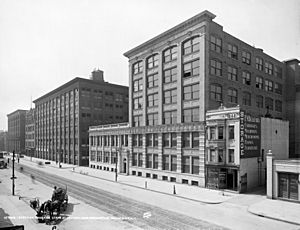
The letter 'k' was a favorite of George Eastman, who said it seemed like a "strong, sharp letter." He and his mother, Maria, came up with the name Kodak using an Anagrams game. Eastman wanted a name that was short, easy to say, and didn't sound like anything else.
An advertisement from 1920 said the name "was simply invented—made up from letters of the alphabet to meet our trade-mark needs. It was short and pleasant to hear and likely to stay in people's minds." The name Kodak was officially registered as a trademark in 1888.
Starting the Company
George Eastman teamed up with Henry A. Strong in 1880, and they started the Eastman Dry Plate Company on January 1, 1881. At first, they sold dry plates for cameras. But Eastman became interested in replacing glass plates with a new roll film process.
In 1884, the company changed its name to the Eastman Dry Plate and Film Company. In 1885, Eastman patented a way to hold film rolls, which let cameras store many pictures at once. He also patented a type of paper film called "American film." Eastman kept working on cameras and hired chemist Henry Reichenbach to make the film better. This led to a patent in 1889 for nitrocellulose film.
As the company grew, it changed its name a few more times. On May 23, 1892, it was renamed Eastman Kodak.
The First Kodak Camera
In 1888, Eastman patented the Kodak camera. It was a simple box camera with a lens that stayed focused and no viewfinder. It had a key to move the film, a string to set the shutter, and a button to take the picture.
The camera cost $25 and came with a film roll for 100 pictures. You could mail the camera to Kodak's headquarters in Rochester with $10 for developing the film. Kodak would send back the printed photos, the negatives, and a new roll of film. This made photography much easier and cheaper for everyone.
The camera was a huge hit, and it started a trend of amateur photography. Eastman's advertising slogan, "You Press the Button, We Do the Rest", became very famous.
Growing Bigger
In the late 1800s and early 1900s, Kodak grew very fast. George Eastman realized that film would make more money than the cameras themselves, so he focused on controlling the film market. This business model stayed the same for many years.
Kodak built larger facilities in Rochester, called Kodak Park, starting in 1890. The company also bought and opened several shops and factories in Europe, especially in the United Kingdom. An Australian branch was started in 1908.
The Brownie camera, made for children, was first released in 1900. This camera helped even more people get into photography. One of the biggest markets for film became the new motion picture industry. By 1922, Kodak was the second-largest buyer of silver in the United States. In 1930, Kodak was even included in the Dow Jones Industrial Average, a list of major companies.
During World War I, Kodak started a photography school to train pilots for aerial reconnaissance (taking pictures from planes). After the war, in 1920, Kodak bought a chemical plant and started Eastman Tennessee, which later became the Eastman Chemical Company.
In 1912, Kodak opened the Kodak Research Laboratories. Their research mainly focused on making better film for color photography and radiography (X-rays). In 1915, Kodak started selling Kodachrome, a type of color film.
Helping Employees
Kodak became very important to Rochester, where most of its employees lived. In the 1910s and 1920s, George Eastman started many programs to help his workers. These included a fund for workers' compensation in 1910 and a program to share profits with all employees in 1912. In 1919, he sold a large part of his company stock to employees at a lower price.
These benefits continued after Eastman retired. In 1928, the company started offering life insurance, disability benefits, and retirement plans. Many other companies in Rochester copied Kodak's ideas to keep their own workers happy. Eastman believed that offering these benefits would make employees loyal and prevent them from forming labor unions.
The Great Depression and New Products
Kodak was affected by the Great Depression, but Rochester didn't suffer as much as other places. Still, about 17% of Kodak's employees lost their jobs between 1929 and 1933. George Eastman, the company's founder, passed away on March 14, 1932.
Despite the tough times, Kodak's research led to new products in the 1930s. In 1935, they launched Kodachrome, a new three-color film that was very successful. The company also started making industrial high-speed cameras and began to expand its chemical business by producing vitamins and plastics.
World War II and Beyond
After the United States entered World War II, Kodak stopped making film for regular people and started helping the American war effort. The company made film, cameras, microfilm, and other materials for the government.
After the war, Kodak continued to grow. In 1948, they created a new acetate film that quickly replaced older, flammable film in the movie industry. In 1958, Kodak started selling super glue. Their cameras were even used by NASA for space missions.
In 1963, Kodak released the first Instamatic cameras, which were their cheapest cameras yet. The company's yearly sales went over $1 billion in 1962 and $2 billion in 1966.
During the Cold War, Kodak worked on secret government projects. They designed cameras and developed film for spy planes like the Lockheed U-2 and for surveillance satellites.
Kodak's way of doing business didn't change much from the 1930s to the 1970s. They were so dominant that they didn't feel the need to change. However, this meant they fell behind rivals like Polaroid and Xerox in making instant cameras and photocopiers. Kodak eventually made their own versions in the mid-1970s, but they weren't very popular and were stopped in the 1990s.
Competition with Fujifilm
In the 1980s, Japanese company Fujifilm entered the U.S. market with cheaper film. Fuji won a bid to be the official film of the 1984 Summer Olympics in Los Angeles, which helped them get a strong position in the market. Fuji's aggressive marketing and lower prices started taking market share from Kodak.
Even with this competition, Kodak's sales and profits kept growing in the 1990s. This was due to some changes in strategy and a growing global market. In 1996, Kodak's yearly sales reached $16 billion.
A price war between Fuji and Kodak started in 1997, which hurt Kodak's profits. Kodak's sales dropped by more than 10% in 1997, and their net earnings fell sharply. Kodak's market share in the United States also went down.
Both Fuji and Kodak saw that digital photography was coming, and they both tried to change their businesses. Fuji was more successful at this. Fuji stopped making motion picture film in 2013, leaving Kodak as the last major producer.
The Shift to Digital
A Kodak employee named Steven Sasson developed the first handheld digital camera in 1975. Another employee, Larry Matteson, wrote a report in 1979 predicting that digital photography would completely take over by 2010. However, Kodak leaders were slow to fully embrace digital technology. They worried it would cost a lot, make their film business unprofitable, and put them against big computer companies.
Instead, Kodak tried to expand its chemical businesses, but most of these efforts lost money. Another attempt to diversify failed when Kodak bought Sterling Drug in 1988 for $5.1 billion, which turned out to be too expensive.
In 1993, George M. C. Fisher became CEO. Under him, Kodak stopped trying to diversify into chemicals and slowly started moving towards digital technology. A key part of this plan was Kodak's digital self-service kiosks in stores. These kiosks let people upload and edit photos, replacing traditional photo developers. Kodak also started making digital cameras, like the Apple QuickTake.
In 2001, film sales began to drop. Under CEO Daniel Carp, Kodak made a big move into the digital camera market with its EasyShare cameras. By 2005, Kodak was number one in U.S. digital camera sales. However, digital cameras had low profit margins because of strong competition, and the market quickly became crowded. Many digital cameras were sold at a loss. The film business, where Kodak made a lot of money, also continued to decline. By 2010, Kodak had dropped to seventh place in digital camera sales. Also, more and more pictures were being taken on cell phones and smartphones, not dedicated digital cameras.
New Plans and Bankruptcy
Kodak changed its strategy again after Antonio Pérez became CEO in 2005. Kodak used to do all its development and manufacturing in-house, but Pérez closed factories and outsourced manufacturing. Kodak stopped making film cameras and began ending the production of many film products. Between 2004 and 2007, 13 film plants and 130 photo processing facilities were closed, and 50,000 employees were laid off. In 2009, Kodak announced it would stop selling Kodachrome color film after 74 years, because sales had dropped so much.
Pérez invested a lot in digital technologies and new services to increase profits. He also spent hundreds of millions of dollars to build a profitable printer ink business to make up for falling film sales. This was a risky move because there was a lot of competition in the printer market.
Kodak's finances and stock value kept falling. In 2009, the company got a $300 million loan. They sold off many parts of the company to pay debts, including the Kodak Health Group, which was one of their profitable units.
By 2011, Kodak was quickly running out of cash. In December 2011, two board members resigned. On January 19, 2012, the company filed for Chapter 11 bankruptcy protection. They got a $950 million loan to keep operating.
During the bankruptcy process, Kodak sold many of its patents for about $525 million to a group of companies including Apple, Google, Facebook, Amazon, Microsoft, and Samsung. Kodak also announced it would stop making several products, including digital cameras, pocket video cameras, digital picture frames, and inkjet printers. As part of a deal, Kodak sold its photographic film, commercial scanners, and photo kiosk businesses, which became a new company called Kodak Alaris.
On September 3, 2013, Kodak announced that it had emerged from bankruptcy. It was now a technology company focused on imaging for businesses.
After Bankruptcy
In March 2014, Jeffrey J. Clarke became Kodak's new CEO. By the end of 2016, Kodak reported its first yearly profit since going bankrupt.
In recent years, Kodak has allowed other companies to use its brand name for various products. For example, JK Imaging has made Micro Four-Thirds cameras under the Kodak brand since 2013. The Kodak Ektra, a smartphone, was launched in 2016. Digital tablets were announced in 2017.
Even with the focus on digital technology, film is still a big part of Kodak's business. The company continues to supply film to the motion picture industry. In 2022, Kodak announced it would hire new film technicians because film photography has become popular again with hobbyists.
What Kodak Makes Today
Kodak today has four main business areas: Traditional Print, Digital Print, Advanced Material & Chemicals (which includes Motion Picture film), and Brand (licensing the Kodak name to other companies).
Kodak is the main supplier of film for the American movie industry. They also provide packaging, printing, graphic communications, and services for international businesses.
Kodak Alaris, a company in the UK, owns the rights to still photographic films and the Kodak Moments photo kiosk businesses.
Advanced Materials & Chemicals
This part of Kodak makes special materials and chemicals.
Materials
- KodaCOLOR Fabric Inks
- KodaLUX Fabric coating
- Silver Anti-microbial materials and coating
Chemicals
- They also make specialty chemicals for other companies.
Industrial Films
- Kodak Aerocolor IV 125 2460 Color Negative Aerial Film (for aerial photography)
- Kodak ACCUMAX plotter films (for printed circuit boards)
- Kodak ESTAR polyester films
Motion Picture Film
Many modern movies and TV shows are still filmed using Kodak film.
Motion picture camera films are made in 8mm, 16mm, and 35mm sizes. Kodak also makes other technical films for movies, like those used for copies and sound, along with the chemicals needed to process them.
Camera Films include:
- Black & White Negative Stock:
- Kodak Double X 5222/7222
- Black & White Reversal Stock:
- Kodak Tri-X 7266
- Color Negative Stocks:
- Kodak Vision 3 50D 5203/7203
- Kodak Vision 3 250D 5207/7207
- Kodak Vision 3 200T 5213/7213
- Kodak Vision 3 500T 5219/7219
- Color Reversal Stocks:
- Kodak Ektachrome 100D 7294
Still Film
Kodak Alaris buys and sells Kodak-branded still films from Eastman Kodak. Eastman Kodak also makes and packages film for other brands like Cinestill and Lomography. Since 2022, Fujifilm has even bought some color negative films from Kodak.
Kodak currently makes several types of photographic film in 35mm and 120 film sizes. Because more hobbyists want film, Kodak brought back a new version of the Ektachrome 100 film in 2018.
- Black & White Negative Film:
- Kodak Tri-X 320
- Kodak Tri-X 400
- Kodak TMAX 100
- Kodak TMAX 400
- Kodak TMAX P3200
- Color Negative Film (for everyday use):
- Kodak ColorPlus/Kodacolor 200
- Kodak ProImage 100
- Kodak Gold 200
- Kodak Ultramax 400
- Kodak Ultramax 800 (mostly in disposable cameras)
- Color Negative Film (for professionals):
- Kodak Ektar 100
- Kodak Portra 160
- Kodak Portra 400
- Kodak Portra 800
- Color Reversal Film:
- Kodak Ektachrome E100
Reversal film (or slide film) creates a positive image on a clear base.
Traditional and Digital Printing
Kodak makes commercial inkjet printers, special printing equipment, and the supplies and services that go with them. They sell Prosper, Nexfinity, and Uteco printers. Kodak also designs products for flexography printing through its Flexcel brand. They have also sold computer to plate (CTP) devices since 1995.
Kodak works with companies that make touch-panels for functional printing.
In 1997, Heidelberg Printing Machines AG and Eastman Kodak Co. created a joint company to develop a digital color printing press. In 2004, Heidelberg transferred its Digital Print division to Kodak.
Brand Licensing
The Kodak brand name is licensed to other companies for various consumer products, like the PIXPRO digital cameras made by JK Imaging.
Batteries
Kodak licenses its brand name for alkaline, lithium, hearing aid, and button cell batteries.
Professional Photo Chemistry
The rights to Kodak professional photo chemicals were given to Kodak Alaris in 2012. In 2020, Alaris sold these rights to Sino Promise, a Chinese company. However, in early 2023, Sino Promise decided to stop this business. This allowed Photo Systems Inc. in the US to buy the brand rights directly from Eastman Kodak in September 2023. They plan to bring back the full range of Black & White, C-41, RA-4, and E6 photo chemicals.
What Kodak Used to Make
Photographic Film and Paper
Kodak still makes special films and film for popular consumer formats, but they have stopped making film in most older sizes. One of their most famous discontinued films was Kodachrome.
Kodak was a major producer of silver halide paper used for printing from film and digital images. In 2005, Kodak announced it would stop making black-and-white photo paper. All paper manufacturing was moved to Kodak Alaris in 2013.
Still Film Cameras
Kodak sold film cameras from its start in 1888 until 2007. Their most popular models in the 20th century were the Brownie (1900–1986) and the Instamatic (1968–1988).
Between 1914 and 1932, some Kodak cameras had an autographic feature that let you write notes on the edge of the negative when you took the picture.
In 1982, Kodak launched new disc film cameras. They sold well at first because they were small, but people didn't like their poor image quality, so they were stopped in 1988.
On January 13, 2004, Kodak announced it would stop selling traditional film cameras (except disposable cameras) in the United States, Canada, and Western Europe. By the end of 2005, Kodak had stopped making cameras that used the Advanced Photo System.
Slide Projectors
Kodak started selling its Carousel line of slide projectors in 1962. Kodak stopped making slide projectors in October 2004.
Instant Cameras
Kodak was the only supplier of negatives for Polaroid cameras from 1963 to 1969. In 1976, Kodak started selling its own EK instant camera models. These were followed by the Colorburst in 1979 and the Kodamatic in 1982. After losing a patent lawsuit with Polaroid Corporation, Kodak left the instant camera business in 1986.
Image Sensors
In the early 1970s, Kodak began researching CCD sensor image sensors. Kodak developed the first megapixel sensor in 1987. In 1991, a 1.3-megapixel sensor from Kodak was used in Kodak's first digital camera sold to the public, the DCS-100.
The Bayer filter, a way to arrange colors for image sensors, was patented by Kodak scientist Bryce Bayer in 1976.
In 2011, Kodak sold its Image Sensor Solutions business.
Floppy Disks
In 1983, Kodak introduced a special 3.3 million byte diskette. In 1985, Kodak bought Verbatim, a company that made floppy disks. In 1990, Kodak left the diskette business and sold Verbatim.
Digital Cameras
The Kodak DCS series of digital single-lens reflex cameras were released by Kodak in the 1990s and 2000s. In 2003, the Kodak EasyShare series was launched. Kodak found that many people enjoyed taking digital photos but found it hard to get them onto their computers. Kodak tried to solve this with products that made it easy to share photos. One key invention was a printer dock that let people print photos by simply putting their camera into a compact device and pressing a button.
In July 2006, Kodak announced that Flextronics would make and help design its digital cameras. Kodak stopped making its digital cameras in 2012.
Digital Picture Frames
Kodak first entered the digital picture frame market in late 2000. These frames could connect to an online photo network and hold many images. Kodak stopped making digital picture frames in 2012.
Kodak Gallery
In June 2001, Kodak bought the photo-developing website Ofoto, which was later renamed Kodak Gallery. This website let users upload photos, print them, and create products like mousepads. In March 2012, Kodak sold Kodak Gallery to Shutterfly.
Light-Emitting Diodes (LEDs)
Kodak's research into LED technology led to many new ideas starting in the 1980s. In 1987, Kodak chemists Ching Wan Tang and Steven Van Slyke created the first practical organic light-emitting diode (OLED). In 1999, Kodak partnered with Sanyo to make OLED displays. Kodak sold its OLED business to LG Electronics in December 2009.
Medical Technology
Kodak made its first X-ray film in 1896. In the 1970s, Kodak developed the Ektachem Analyzer, a device for medical tests. In 2007, Kodak sold its Kodak Health Group.
Document Imaging
Kodak's work in document imaging started when George Eastman worked with banks to image checks in the 1920s. Kodak's company Recordak was founded in 1928 to make some of the first microfilm. The Document Imaging division was moved to Kodak Alaris in 2013.
Photocopiers and Duplicators
Kodak entered the plain paper photocopier market in 1975. In 1988, IBM sold its photocopier business to Kodak. In 1996, Kodak announced it was selling its Copier business.
Consumer Inkjet Printers
In February 2007, Kodak re-entered the market with new All-in-One (AiO) inkjet printers. Their advertising focused on low prices for ink cartridges. However, these printers did not make enough profit and were a big reason for the company's bankruptcy in 2012. Kodak announced plans to stop selling inkjet printers in 2013.
Photo Kiosks
Kodak's first self-service kiosk opened in 1988. The Picture Maker kiosks were launched in 1994 for digital prints. These kiosks were put in stores to offer a digital version of Kodak's film processing services. Over time, they added features like image editing. The photo kiosks were moved to Kodak Alaris in 2013.
Photography On Demand
In early 2016, Kodak launched Kodakit, a service where people could hire photographers. It was first for weddings and portraits, but then shifted to businesses needing many photos, like for real estate. The service was criticized because photographers had to give up the copyright to their photos. Kodakit stopped operating in January 2020.
Motion Picture and TV Production
Kodak also briefly entered the professional television production video tape market in the mid-1980s. Kodak used to own visual effects film companies like Cinesite and LaserPacific. Kodak sold LaserPacific in 2010 and Cinesite in 2012.
How Kodak Operates Today
Since 2015, Kodak has five business divisions: Print Systems, Enterprise Inkjet Systems, Micro 3D Printing and Packaging, Software and Solutions, and Consumer and Film.
Kodak's main headquarters are at Kodak Tower in downtown Rochester. Its main factory in the United States is Eastman Business Park, where film is made.
Subsidiaries
- Kodak (Australasia) Pty Ltd
- Kodak Canada ULC (formerly Canadian Kodak Company)
- Kodak (Xiamen) Digital Imaging Products Company (in Xiamen, China)
- Kodak Graphic Communications (in Osterode am Harz, Germany)
- Kodak Limited (UK)
Kodak Teenage Film Awards
Since 1962, Kodak, along with other groups, presented the yearly Teenage Film Awards. To enter, you had to be no older than 19, and your film could be 8mm, super 8, or 16mm, on any topic.
Eric Goldberg's Super-8 film won the Grand Prize in 1974.
Important People at Kodak
Leaders
| Name | Title | Time in Role |
|---|---|---|
| Henry A. Strong | President | 1884 – July 26, 1919 |
| George Eastman | President | 1921 – April 7, 1925 |
| William G. Stuber | President | 1925–1934 |
| Frank W. Lovejoy | President | 1934–1941 |
| Thomas J. Hargrave | President | 1941–1952 |
| Albert K. Chapman | President | 1952–1960 |
| William S. Vaughn | President and CEO | 1960 – December 31, 1968 |
| Louis K. Eilers | President and CEO | January 1, 1969 – May 17, 1972 |
| Robert Moyer | President | 1976–1989 |
| Gerald B. Zornow | Chairman | 1970–1984 |
| Walter A. Fallon | CEO | May 18, 1972 – 1983 |
| Colby H. Chandler | CEO | May 1983 – June 1990 |
| Kay R. Whitmore | CEO | June 1990 – October 27, 1993 |
| George M. C. Fisher | CEO | October 28, 1993 – December 31, 1999 |
| Daniel A. Carp | CEO | January 1, 2000 – May 31, 2005 |
| Antonio M. Pérez | Chairman and CEO | June 1, 2005 – 2014 |
| Jeff Clarke | CEO | March 12, 2014 – February 21, 2019 |
| Jim Continenza | Executive chairman | February 21, 2019 – present |
Board of Directors
As of July 2022, the board includes:
- James Continenza, chairman and CEO of Kodak
- B. Thomas Golisano, founder of Paychex
- Philippe Katz, UECC executive
- Katherine B. Lynch, former COO of UBS
- Jason New, co-CEO of Onex Credit
- Darren L. Richman, co-founder of KLIM investment group
- Michael E. Selick, Jr., president of SeaAgri Solutions
Scientists
- Bryce Bayer, color scientist
- Harry Coover, polymer chemist
- Marion B. Folsom, statistician
- Kenneth Mees, film scientist and founder of the research laboratories
- Steven Sasson, electrical engineer (invented the first digital camera)
- Steven Van Slyke, OLED scientist
- Ching W. Tang, OLED scientist
Kodak's Archives
In 2005, Kodak Canada gave its entire collection of historical company records to Ryerson University in Toronto, Canada. This collection includes Kodak's Camera Collection, old photos, files, magazines, price lists, and equipment. It also has the contents of the Kodak Heritage Collection Museum, which was a museum started in 1999 for Kodak Canada's 100th birthday.
See also
 In Spanish: Kodak para niños
In Spanish: Kodak para niños
- Eastman Business Park, formerly Kodak Park
- Kodak Vision Award


